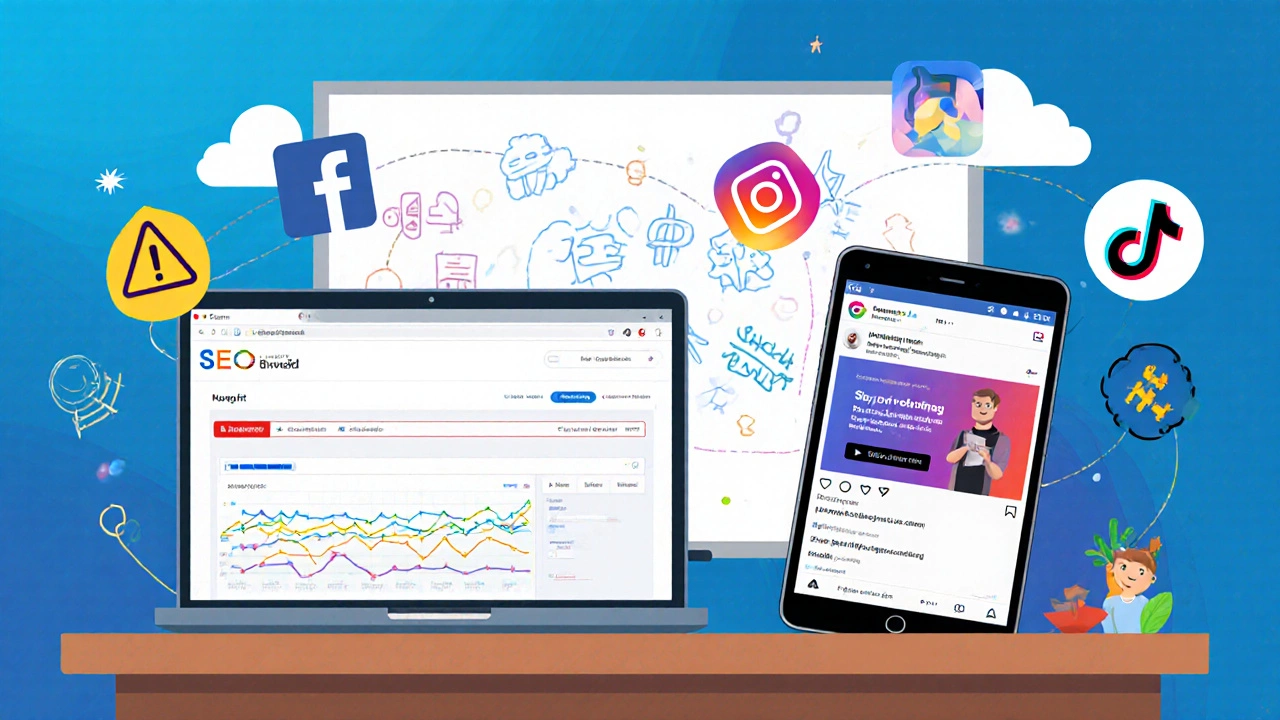Digital Marketer Role Explained - Daily Tasks & Required Skills

Digital Marketing Salary Calculator
Estimate your potential salary based on experience level and industry
$52,500 - $65,000
Based on your selection: Junior level in Technology industry, United States
How This Calculator Works
This tool estimates salary ranges based on industry benchmarks from the article. Salaries vary based on company size, specific role, and individual performance. The calculator shows national averages for U.S. digital marketing roles with typical adjustments for location and industry.
Ever wonder what a digital marketer actually does all day? Forget the vague idea of “posting on social media” - the role blends creativity, data crunching, and tech know‑how to drive real business results. Below you’ll see the exact tasks, tools, and skills that turn clicks into customers.
Core responsibilities at a glance
At its core, a digital marketer plans, executes, and optimizes campaigns across every online channel. This means mapping out a customer journey, creating content that fits each touchpoint, and constantly measuring performance to tweak the next move. In short, the job is a cycle of strategy → execution → analysis → refinement. The following sections break down each stage.
Content creation and strategy
Content marketing is the practice of planning, creating, and distributing valuable content to attract and retain a clearly defined audience. A digital marketer starts by researching audience personas, keyword intent, and competitor gaps. From blog posts and videos to infographics and podcasts, the goal is to answer the questions prospects are already asking. A typical week might include drafting an editorial calendar, briefing writers, and reviewing drafts for SEO alignment and brand voice.
Search engine optimization (SEO)
SEO optimizes website content so search engines can understand and rank it. The digital marketer conducts keyword research, audits on‑page elements (title tags, headings, meta descriptions), and coordinates with developers to fix technical issues like broken links or slow load times. Over time, they track organic traffic, click‑through rates, and rankings to ensure the site climbs higher in Google’s SERPs.

Social media advertising & community management
Social media advertising uses paid campaigns on platforms like Facebook, Instagram, LinkedIn, and TikTok to reach targeted audiences. Beyond paid ads, the marketer engages organically by responding to comments, curating user‑generated content, and running community contests. Each platform has its own ad format-carousel, story, or video-and a digital marketer pairs the format with audience insights to maximize relevance and ROI.
Email marketing & automation
Email marketing delivers personalized messages to a subscriber list to nurture leads and drive conversions. The marketer designs welcome series, abandoned‑cart reminders, and monthly newsletters. With automation tools, they set triggers based on user behavior (e.g., a purchase or a website visit) and test subject lines, copy, and send times to improve open and click rates.
Paid search & PPC campaigns
PPC (pay‑per‑click) allows advertisers to bid on keywords so their ads appear at the top of search results. A digital marketer builds campaigns in Google Ads or Bing Ads, selects high‑intent keywords, writes ad copy, and sets daily budgets. Continuous A/B testing of headlines, landing pages, and bids ensures the cost per acquisition (CPA) stays within target limits.
Data analysis & reporting
Analytics collects and interprets data from websites, ads, and emails to inform decisions. The marketer pulls data from Google Analytics, platform dashboards, and CRM reports. Key metrics-traffic sources, conversion rates, lifetime value-are visualized in weekly or monthly performance reports. Insightful dashboards help stakeholders see growth trends and where budget should shift.

Brand strategy & influencer collaborations
Brand strategy defines a company's voice, positioning, and visual identity across all channels. A digital marketer ensures every campaign reflects the brand’s tone and visual guidelines. They also scout micro‑ and macro‑influencers whose audiences align with the brand. By negotiating contracts, creating brief guidelines, and measuring earned media, the marketer amplifies reach without blowing the ad budget.
Toolset & tech stack
Modern digital marketers rely on a suite of tools. Here’s a quick checklist:
- Keyword research - Ahrefs, SEMrush, Ubersuggest
- Content planning - Trello, Asana, Notion
- SEO audit - Screaming Frog, Sitebulb
- Social scheduling - Buffer, Hootsuite, Later
- Email automation - Mailchimp, Klaviyo, HubSpot
- PPC management - Google Ads Editor, WordStream
- Analytics - Google Analytics, Data Studio, Mixpanel
- CRM & attribution - HubSpot CRM, Salesforce, Funnel.io
Typical career path and skill development
Most digital marketers start with a bachelor’s degree in marketing, communications, or a related field, but many succeed through certifications and hands‑on experience. Entry‑level roles (e.g., Marketing Assistant) focus on task execution-writing copy, scheduling posts, or pulling basic reports. After 1‑2 years, professionals move into specialist positions like SEO Analyst or Paid Media Manager. With 3‑5 years of breadth across channels, a marketer can graduate to a Digital Marketing Manager who oversees strategy, budget allocation, and team coordination. Senior leaders (Director of Growth, VP of Marketing) blend data‑driven decision‑making with revenue forecasting and cross‑functional collaboration.
| Level | Primary Focus | Typical Tools |
|---|---|---|
| Junior (0‑2yr) | Content creation, basic reporting | Canva, Google Analytics, Buffer |
| Mid (2‑5yr) | Campaign strategy, SEO, PPC management | SEMrush, Google Ads, HubSpot |
| Senior (5+yr) | Team leadership, budget oversight, growth strategy | Data Studio, Salesforce, Tableau |
Frequently Asked Questions
What education background do digital marketers need?
A bachelor’s degree in marketing, communications, or business is common, but many succeed with certifications (Google Ads, HubSpot) and a strong portfolio. Real‑world experience in running campaigns often outweighs formal education.
Which skills are most in‑demand for digital marketers in 2025?
Data analysis, SEO, paid social, and marketing automation are top priorities. Employers also look for comfort with AI‑driven tools, video production, and cross‑channel attribution.
How much can a digital marketer earn?
Entry‑level salaries range from $45k‑$60k in the U.S., mid‑level roles average $70k‑$95k, and senior managers or directors can earn $120k‑$170k+, depending on industry and location.
Do digital marketers need to code?
Basic HTML/CSS knowledge helps with email templates and landing pages, but most tasks rely on no‑code platforms. Understanding URL structure and tracking parameters is more essential than deep programming.
What’s the biggest challenge digital marketers face today?
Attributing revenue to the correct channel is the toughest puzzle. With users hopping across devices and platforms, marketers must stitch together data from cookies, server‑side tracking, and first‑party identifiers to get a clear ROI picture.

Post-Comment